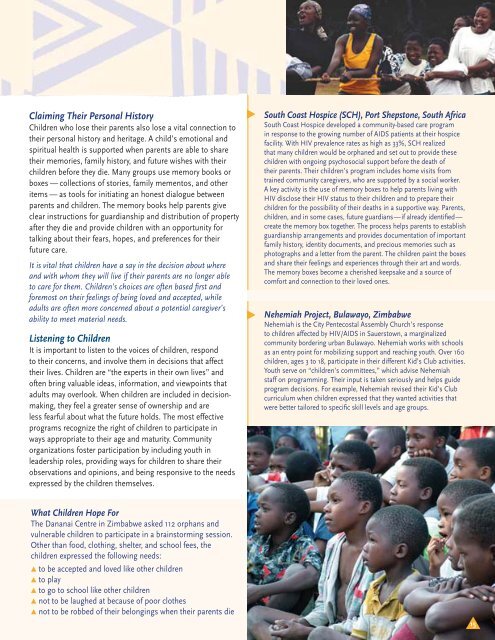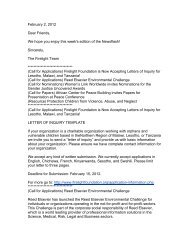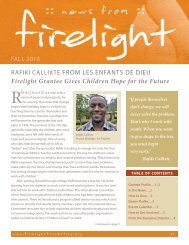From Faith to Action - Faith to Action Initiative
From Faith to Action - Faith to Action Initiative
From Faith to Action - Faith to Action Initiative
- No tags were found...
Create successful ePaper yourself
Turn your PDF publications into a flip-book with our unique Google optimized e-Paper software.
Claiming Their Personal His<strong>to</strong>ryChildren who lose their parents also lose a vital connection <strong>to</strong>their personal his<strong>to</strong>ry and heritage. A child’s emotional andspiritual health is supported when parents are able <strong>to</strong> sharetheir memories, family his<strong>to</strong>ry, and future wishes with theirchildren before they die. Many groups use memory books orboxes — collections of s<strong>to</strong>ries, family memen<strong>to</strong>s, and otheritems — as <strong>to</strong>ols for initiating an honest dialogue betweenparents and children. The memory books help parents giveclear instructions for guardianship and distribution of propertyafter they die and provide children with an opportunity fortalking about their fears, hopes, and preferences for theirfuture care.It is vital that children have a say in the decision about whereand with whom they will live if their parents are no longer able<strong>to</strong> care for them. Children’s choices are often based fi rst andforemost on their feelings of being loved and accepted, whileadults are often more concerned about a potential caregiver’sability <strong>to</strong> meet material needs.Listening <strong>to</strong> ChildrenIt is important <strong>to</strong> listen <strong>to</strong> the voices of children, respond<strong>to</strong> their concerns, and involve them in decisions that affecttheir lives. Children are “the experts in their own lives” andoften bring valuable ideas, information, and viewpoints thatadults may overlook. When children are included in decisionmaking,they feel a greater sense of ownership and areless fearful about what the future holds. The most effectiveprograms recognize the right of children <strong>to</strong> participate inways appropriate <strong>to</strong> their age and maturity. Communityorganizations foster participation by including youth inleadership roles, providing ways for children <strong>to</strong> share theirobservations and opinions, and being responsive <strong>to</strong> the needsexpressed by the children themselves.South Coast Hospice (SCH), Port Sheps<strong>to</strong>ne, South AfricaSouth Coast Hospice developed a community-based care programin response <strong>to</strong> the growing number of AIDS patients at their hospicefacility. With HIV prevalence rates as high as 33%, SCH realizedthat many children would be orphaned and set out <strong>to</strong> provide thesechildren with ongoing psychosocial support before the death oftheir parents. Their children’s program includes home visits fromtrained community caregivers, who are supported by a social worker.A key activity is the use of memory boxes <strong>to</strong> help parents living withHIV disclose their HIV status <strong>to</strong> their children and <strong>to</strong> prepare theirchildren for the possibility of their deaths in a supportive way. Parents,children, and in some cases, future guardians—if already identified—create the memory box <strong>to</strong>gether. The process helps parents <strong>to</strong> establishguardianship arrangements and provides documentation of importantfamily his<strong>to</strong>ry, identity documents, and precious memories such aspho<strong>to</strong>graphs and a letter from the parent. The children paint the boxesand share their feelings and experiences through their art and words.The memory boxes become a cherished keepsake and a source ofcomfort and connection <strong>to</strong> their loved ones.Nehemiah Project, Bulawayo, ZimbabweNehemiah is the City Pentecostal Assembly Church’s response<strong>to</strong> children affected by HIV/AIDS in Sauers<strong>to</strong>wn, a marginalizedcommunity bordering urban Bulawayo. Nehemiah works with schoolsas an entry point for mobilizing support and reaching youth. Over 160children, ages 3 <strong>to</strong> 18, participate in their different Kid’s Club activities.Youth serve on “children’s committees,” which advise Nehemiahstaff on programming. Their input is taken seriously and helps guideprogram decisions. For example, Nehemiah revised their Kid’s Clubcurriculum when children expressed that they wanted activities thatwere better tailored <strong>to</strong> specifi c skill levels and age groups.What Children Hope ForThe Dananai Centre in Zimbabwe asked 112 orphans andvulnerable children <strong>to</strong> participate in a brains<strong>to</strong>rming session.Other than food, clothing, shelter, and school fees, thechildren expressed the following needs:▲ <strong>to</strong> be accepted and loved like other children▲ <strong>to</strong> play▲ <strong>to</strong> go <strong>to</strong> school like other children▲ not <strong>to</strong> be laughed at because of poor clothes▲ not <strong>to</strong> be robbed of their belongings when their parents die15








